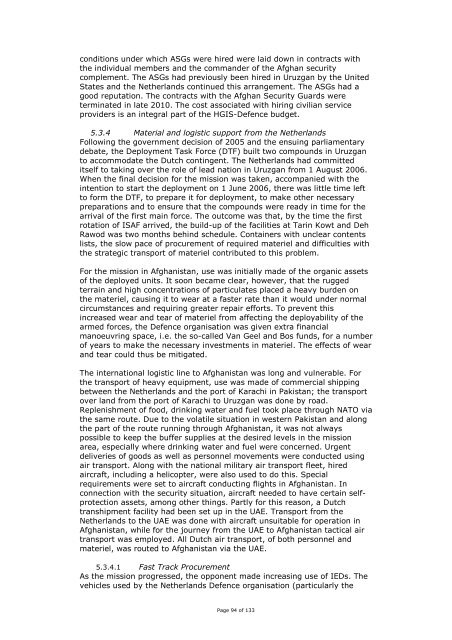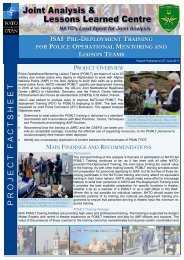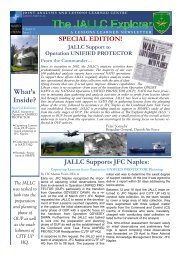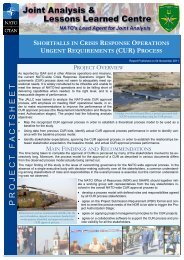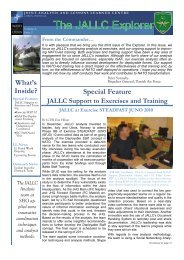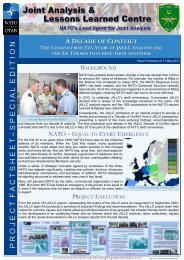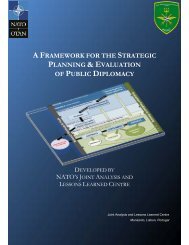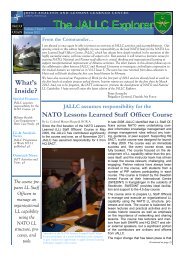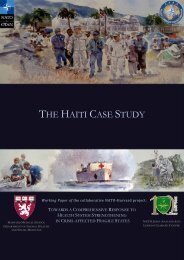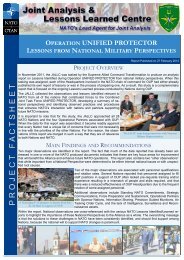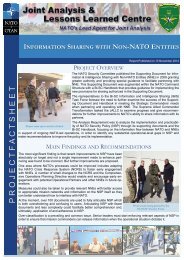conditions under which ASGs were hired were laid down <strong>in</strong> contracts withthe <strong>in</strong>dividual members and the commander of the Afghan securitycomplement. The ASGs had previously been hired <strong>in</strong> Uruzgan by the UnitedStates and the <strong>Netherlands</strong> cont<strong>in</strong>ued this arrangement. The ASGs had agood reputation. The contracts with the Afghan Security Guards wereterm<strong>in</strong>ated <strong>in</strong> late <strong>2010</strong>. The cost associated with hir<strong>in</strong>g civilian serviceproviders is an <strong>in</strong>tegral part of the HGIS-Defence budget.5.3.4 Material and logistic support from the <strong>Netherlands</strong>Follow<strong>in</strong>g the government decision of 2005 and the ensu<strong>in</strong>g parliamentarydebate, the Deployment Task Force (DTF) built two compounds <strong>in</strong> Uruzganto accommodate the Dutch cont<strong>in</strong>gent. The <strong>Netherlands</strong> had committeditself to tak<strong>in</strong>g over the role of lead nation <strong>in</strong> Uruzgan from 1 August <strong>2006</strong>.When the f<strong>in</strong>al decision for the mission was taken, accompanied with the<strong>in</strong>tention to start the deployment on 1 June <strong>2006</strong>, there was little time leftto form the DTF, to prepare it for deployment, to make other necessarypreparations and to ensure that the compounds were ready <strong>in</strong> time for thearrival of the first ma<strong>in</strong> force. The outcome was that, by the time the firstrotation of <strong>ISAF</strong> arrived, the build-up of the facilities at Tar<strong>in</strong> Kowt and DehRawod was two months beh<strong>in</strong>d schedule. Conta<strong>in</strong>ers with unclear contentslists, the slow pace of procurement of required materiel and difficulties withthe strategic transport of materiel contributed to this problem.For the mission <strong>in</strong> Afghanistan, use was <strong>in</strong>itially made of the organic assetsof the deployed units. It soon became clear, however, that the ruggedterra<strong>in</strong> and high concentrations of particulates placed a heavy burden onthe materiel, caus<strong>in</strong>g it to wear at a faster rate than it would under normalcircumstances and requir<strong>in</strong>g greater repair efforts. To prevent this<strong>in</strong>creased wear and tear of materiel from affect<strong>in</strong>g the deployability of thearmed forces, the Defence organisation was given extra f<strong>in</strong>ancialmanoeuvr<strong>in</strong>g space, i.e. the so-called Van Geel and Bos funds, for a numberof years to make the necessary <strong>in</strong>vestments <strong>in</strong> materiel. The effects of wearand tear could thus be mitigated.The <strong>in</strong>ternational logistic l<strong>in</strong>e to Afghanistan was long and vulnerable. Forthe transport of heavy equipment, use was made of commercial shipp<strong>in</strong>gbetween the <strong>Netherlands</strong> and the port of Karachi <strong>in</strong> Pakistan; the transportover land from the port of Karachi to Uruzgan was done by road.Replenishment of food, dr<strong>in</strong>k<strong>in</strong>g water and fuel took place through NATO viathe same route. Due to the volatile situation <strong>in</strong> western Pakistan and alongthe part of the route runn<strong>in</strong>g through Afghanistan, it was not alwayspossible to keep the buffer supplies at the desired levels <strong>in</strong> the missionarea, especially where dr<strong>in</strong>k<strong>in</strong>g water and fuel were concerned. Urgentdeliveries of goods as well as personnel movements were conducted us<strong>in</strong>gair transport. Along with the national military air transport fleet, hiredaircraft, <strong>in</strong>clud<strong>in</strong>g a helicopter, were also used to do this. Specialrequirements were set to aircraft conduct<strong>in</strong>g flights <strong>in</strong> Afghanistan. Inconnection with the security situation, aircraft needed to have certa<strong>in</strong> selfprotectionassets, among other th<strong>in</strong>gs. Partly for this reason, a Dutchtranshipment facility had been set up <strong>in</strong> the UAE. Transport from the<strong>Netherlands</strong> to the UAE was done with aircraft unsuitable for operation <strong>in</strong>Afghanistan, while for the journey from the UAE to Afghanistan tactical airtransport was employed. All Dutch air transport, of both personnel andmateriel, was routed to Afghanistan via the UAE.5.3.4.1 Fast Track ProcurementAs the mission progressed, the opponent made <strong>in</strong>creas<strong>in</strong>g use of IEDs. Thevehicles used by the <strong>Netherlands</strong> Defence organisation (particularly thePage 94 of 133
Mercedes Benz terra<strong>in</strong> vehicle, the Patria, the YPR-765 and, at a laterstage, the Vik<strong>in</strong>g) turned out to be vulnerable to these IEDs, and certa<strong>in</strong>adaptations were therefore made to these vehicles to reduce thisvulnerability. In addition, this led to an urgent requirement for vehicles thatwere better protected aga<strong>in</strong>st IEDs. A so-called Fast Track Procurementprocedure, which was specifically designed for this purpose, ensured theswift acquisition of a number of Bushmaster vehicles. This vehicle has anarmoured and V-shaped underside that gives it very good protectionaga<strong>in</strong>st IEDs. Hav<strong>in</strong>g these vehicles at his disposal gave the commander ofthe TFU more possibilities for adapt<strong>in</strong>g the choice of vehicle to the varioussituations and activities that Dutch units were <strong>in</strong>volved <strong>in</strong>. The need for<strong>in</strong>creased and improved reconnaissance capabilities and counter-IEDcapabilities was addressed <strong>in</strong> a similar fashion. Armoured personnelquarters could also be acquired through the FTP procedure. The FTPensured that new, urgent requirements and lessons learned could beaddressed flexibly and relatively quickly. The FTP procedure turned out tobe a useful method to make adequate materiel available to units <strong>in</strong>Afghanistan <strong>in</strong> a quick and diligent manner. It contributed to the securityand flexibility of the TFU. An <strong>in</strong>herent side-effect of the FTP is that there isless room for allow<strong>in</strong>g competition, which may cause the cost to rise. Forthat reason, the FTP procedure was used only <strong>in</strong> exceptional and acutecases.5.3.4.2 RedeploymentFor the preparation and implementation of the redeployment of the TFU’smateriel to the <strong>Netherlands</strong>, a Redeployment Task Force (RDTF) wasformed. The RDTF’s mission was to transport, <strong>in</strong> pr<strong>in</strong>ciple, all of the Dutchmateriel back to the <strong>Netherlands</strong> <strong>in</strong> a controlled and monitored fashion,after which it was to be made operational aga<strong>in</strong> as much as possible, andmade available for use aga<strong>in</strong>. S<strong>in</strong>ce at the time of the RDTF’s formation itwas not clear yet whether and to what extent it would be possible totransfer or sell materiel to partners <strong>in</strong> the mission area, it was decided toprepare for a maximum personnel requirement. When work started, on 1August <strong>2010</strong>, it became clear straight away that considerable quantities ofmateriel could be transferred to partners so that less manpower wasneeded.To ensure that redeployment would proceed <strong>in</strong> a controlled and monitoredfashion, all of the present materiel had to be listed, quantities had to beverified and compared to the quantities orig<strong>in</strong>ally provided, and thecondition of the materiel had to be established. The materiel was thentransported to the port of Karachi ma<strong>in</strong>ly by road, to be transported to the<strong>Netherlands</strong> by sea. Because <strong>ISAF</strong> could temporarily not provideguaranteed air support dur<strong>in</strong>g convoy operations, it was decided to keepthe Apache attack helicopters <strong>in</strong> operation for one more month <strong>in</strong> Uruzgan.Air support for Dutch convoys, as well as for coalition partners, was thusassured dur<strong>in</strong>g that period too. Specific strategic assets, such as selfpropelledhowitzers, were transferred to the <strong>Netherlands</strong> directly by air.The f<strong>in</strong>al <strong>in</strong>ventory concern<strong>in</strong>g materiel can only be made when theredeployment process has been fully completed.Page 95 of 133
- Page 1 and 2:
Final evaluationNetherlands contrib
- Page 3 and 4:
High mountainsLow mountainsPlains a
- Page 5 and 6:
Table of ContentsDutch military per
- Page 7 and 8:
Dutch military personnel deceased i
- Page 9 and 10:
Page 9 of 133
- Page 11 and 12:
1 IntroductionThe government would,
- Page 13 and 14:
The structure of the final evaluati
- Page 15 and 16:
2 The international presence in Afg
- Page 17 and 18:
insurgents in, particularly, the ea
- Page 19 and 20:
3 Netherlands policy for participat
- Page 21 and 22:
Netherlands’ presence. Furthermor
- Page 23 and 24:
“The objectives of this stabilisa
- Page 25 and 26:
In December 2005, the Netherlands g
- Page 27 and 28:
The expectation is that meaningful
- Page 29 and 30:
3.6.2 Implementation of national pr
- Page 31 and 32:
4 Implementation of the mission and
- Page 33 and 34:
tasks to fulfil in the area of secu
- Page 35 and 36:
such as the Bushmaster, that was be
- Page 37 and 38:
Afghan partner unit, at all times o
- Page 39 and 40:
northern part of Deh Rawod in 2007.
- Page 41 and 42:
in large and small bases, while con
- Page 43 and 44: previously thought and comprised a
- Page 45 and 46: Apart from facilitating training an
- Page 47 and 48: If operations in close proximity of
- Page 49 and 50: As previously mentioned, the preven
- Page 51 and 52: - Between 2006 and 2010, the number
- Page 53 and 54: government of Chora in January 2010
- Page 55 and 56: At the beginning of the Dutch missi
- Page 57 and 58: intermediary of TLO and political a
- Page 59 and 60: interest for filling judicial posit
- Page 61 and 62: During the Uruzgan mission, a great
- Page 63 and 64: structurally change governance in U
- Page 65 and 66: development programmes. Before the
- Page 67 and 68: also the way in which Afghans perce
- Page 69 and 70: tailored to the real needs of the p
- Page 71 and 72: Gizab had increased and there was a
- Page 73 and 74: The DCU programme devoted and still
- Page 75 and 76: purpose of these loans, cooperative
- Page 77 and 78: In view of the lack of enthusiasm a
- Page 79 and 80: 5 Expenditure for the mission and i
- Page 81 and 82: Overview of long-term expenditure a
- Page 83 and 84: expenditure related to the deployme
- Page 85 and 86: Multi-year expenditure, Foreign Aff
- Page 87 and 88: explosive ordnance disposal, armour
- Page 89 and 90: this situation as constraining, for
- Page 91 and 92: organised at a later stage. In addi
- Page 93: occupational social workers and the
- Page 97 and 98: 6 ConclusionsThis chapter begins wi
- Page 99 and 100: The first part of the central quest
- Page 101 and 102: At the end of 2005, the Afghan auth
- Page 103 and 104: province. This, too, was done by me
- Page 105 and 106: area, increased sales of agricultur
- Page 107 and 108: ISAF and the OEF led to extra coord
- Page 109 and 110: d. The recommendations from advisor
- Page 111 and 112: Page 111 of 133
- Page 113 and 114: Annex A, Afghanistan Compact Benchm
- Page 115 and 116: end-2010, reforms will strengthen t
- Page 117 and 118: Afghan Cultural HeritageA comprehen
- Page 119 and 120: Private Sector Development and Trad
- Page 121 and 122: Annex B, Results of the socio-econo
- Page 123 and 124: EducationTLO data:• In 2006 there
- Page 125 and 126: Overview of the number of children
- Page 127 and 128: Annex C, Chronology200522 December:
- Page 129 and 130: July: microcredit provider World Co
- Page 131 and 132: Annex D, List of abbreviations3DADZ
- Page 133: Page 133 of 133


